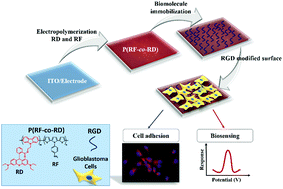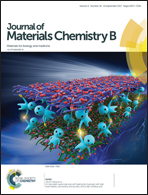Rhodamine functionalized conducting polymers for dual intention: electrochemical sensing and fluorescence imaging of cells†
Abstract
We report here the electrochemical co-polymerization of two functional monomers, one containing fluorescent rhodamine dye (RF) and the other monomer having amine groups (RD), onto electroactive Indium Tin Oxide (ITO) glass. After one step preparation of these surfaces, a three peptide called ArginylGlysylAspartic acid (RGD) was immobilized via EDC chemistry by using amine groups (P(RF-co-RD)/RGD) of the co-polymer, for further use in various bio-applications such as cell adhesion and imaging as well as electrochemical cell sensing. The resultant RGD bound and also fluorescent platforms were utilized as targeted adhesion materials towards integrin avb3 receptor positive (U87-MG) cells and the selectivity was checked by using HaCaT cells as a control. Finally, electrochemical measurements were carried out to characterize step by step surface modification and detection of cell attachment. As a result, P(RF-co-RD)/RGD is a promising material for multi-purpose uses, such as fluorescence imaging without the need for an additional dye for cell visualization and as a targeted adhesion and electrochemical cell sensing platform.



 Please wait while we load your content...
Please wait while we load your content...